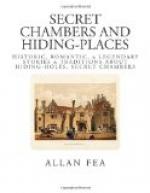[Illustration: SALFORD PRIOR HALL, WARWICKSHIRE]
[Illustration: SALFORD PRIOR HALL]
[Illustration: HIDING-PLACE, SALFORD PRIOR]
[Illustration: HIDING-PLACE, SALFORD PRIOR (SHEWING ENTRANCE)]
Another hiding place as artfully contrived and as little changed since the day it was manufactured is one at Sawston, the ancestral seat of the old family of Huddleston. Sawston Hall is a typical Elizabethan building. The one which preceded it was burnt to the ground by the adherents of Lady Jane Grey, as the Huddleston of that day, upon the death of King Edward VI., received his sister Mary under his protection, and contrived her escape to Framlingham Castle, where she was carried in disguise, riding pillion behind a servant.
The secret chamber, as at Harvington, is on the top landing of the staircase, and the entrance is so cleverly arranged that it slants into the masonry of a circular tower without showing the least perceptible sign from the exterior of a space capable of holding a baby, far less a man. A particular board in the landing is raised, and beneath it, in a corner of the cavity, is found a stone slab containing a circular aperture, something after the manner of our modern urban receptacles for coal. From this hole a tunnel slants downwards at an angle into the adjacent wall, where there is an apartment some twelve feet in depth, and wide enough to contain half a dozen people—that is to say, not bulky ones, for the circular entrance is far from large. Blocks of oak fixed upon the inside of the movable floor-board fit with great nicety into their firm oak sockets in the beams, which run at right angles and support the landing, so that the opening is so massive and firm that, unless pointed out, the particular floor-board could never be detected, and when secured from the inside would defy a battering-ram.
[Illustration: OXBURGH HALL, NORFOLK]
The Huddlestons, or rather their connections the Thornboroughs, have an old house at Leyburn, in Yorkshire, named “The Grove,” which also contained its hiding-place, but unfortunately this is one of those instances where alterations and modern conveniences have destroyed what can never be replaced. The priest, Father John Huddleston (who aided King Charles II. to escape, and who, it will be remembered, was introduced to that monarch’s death-bed by way of a secret staircase in the palace of Whitehall), lived in this house some time during the seventeenth century.
One of the most ingenious hiding-places extant is to be seen at Oxburgh Hall, near Stoke Ferry, the grand old moated mansion of the ancient Bedingfield family. In solidity and compactness it is unique. Up in one of the turrets of the entrance gateway is a tiny closet, the floor of which is composed of brickwork fixed into a wooden frame. Upon pressure being applied to one side of this floor, the opposite side heaves up with a groan at its own weight. Beneath




